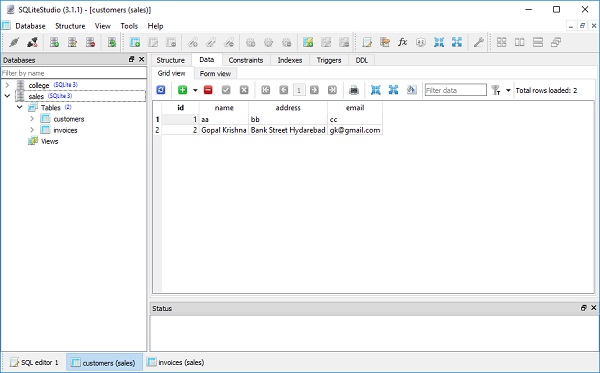📌 相关文章
- 自相关
- 自相关(1)
- 相关python(1)
- 相关python代码示例
- 自相关的类型
- 自相关的类型(1)
- Excel 中的相关图
- Excel 中的相关图(1)
- 如何计算R中的自相关?(1)
- 如何计算R中的自相关?
- c++ 处理 - C++ (1)
- 处理 (1)
- 如何在Python中计算自相关?
- 如何在Python中计算自相关?(1)
- 使用 Matplotlib 的自相关图
- 使用 Matplotlib 的自相关图(1)
- SQL 相关子查询(1)
- SQL 相关子查询
- 相关含义 (1)
- 如何在C++中处理文件处理
- 如何在C ++中处理文件处理
- 如何在C++中处理文件处理(1)
- 如何在C++中处理文件处理
- SQLAlchemy ORM-删除相关对象(1)
- SQLAlchemy ORM-删除相关对象
- 在Python处理时区
- 在Python处理时区(1)
- c++ 处理 - C++ 代码示例
- HTML | DOM 锚相关属性(1)
📜 处理相关对象
📅 最后修改于: 2020-11-27 07:51:07 🧑 作者: Mango
在本章中,我们将重点介绍SQLAlchemy ORM中的相关对象。
现在,当我们创建一个Customer对象时,一个空白的发票集合将以Python列表的形式出现。
c1 = Customer(name = "Gopal Krishna", address = "Bank Street Hydarebad", email = "gk@gmail.com")
c1.invoices的invoices属性将为空列表。我们可以将列表中的项目分配为-
c1.invoices = [Invoice(invno = 10, amount = 15000), Invoice(invno = 14, amount = 3850)]
让我们使用Session对象将此对象提交到数据库,如下所示:
from sqlalchemy.orm import sessionmaker
Session = sessionmaker(bind = engine)
session = Session()
session.add(c1)
session.commit()
这将自动为客户和发票表生成INSERT查询-
INSERT INTO customers (name, address, email) VALUES (?, ?, ?)
('Gopal Krishna', 'Bank Street Hydarebad', 'gk@gmail.com')
INSERT INTO invoices (custid, invno, amount) VALUES (?, ?, ?)
(2, 10, 15000)
INSERT INTO invoices (custid, invno, amount) VALUES (?, ?, ?)
(2, 14, 3850)
现在让我们在SQLiteStudio的表格视图中查看客户表格和发票表格的内容-


您可以通过使用以下命令在构造函数本身中提供发票的映射属性来构造Customer对象-
c2 = [
Customer(
name = "Govind Pant",
address = "Gulmandi Aurangabad",
email = "gpant@gmail.com",
invoices = [Invoice(invno = 3, amount = 10000),
Invoice(invno = 4, amount = 5000)]
)
]
或者使用会话对象的add_all()函数添加的对象列表,如下所示-
rows = [
Customer(
name = "Govind Kala",
address = "Gulmandi Aurangabad",
email = "kala@gmail.com",
invoices = [Invoice(invno = 7, amount = 12000), Invoice(invno = 8, amount = 18500)]),
Customer(
name = "Abdul Rahman",
address = "Rohtak",
email = "abdulr@gmail.com",
invoices = [Invoice(invno = 9, amount = 15000),
Invoice(invno = 11, amount = 6000)
])
]
session.add_all(rows)
session.commit()